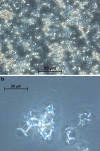Challenges in development of nanoparticle-based therapeutics
- PMID: 22407288
- PMCID: PMC3326161
- DOI: 10.1208/s12248-012-9339-4
Challenges in development of nanoparticle-based therapeutics
Abstract
In recent years, nanotechnology has been increasingly applied to the area of drug development. Nanoparticle-based therapeutics can confer the ability to overcome biological barriers, effectively deliver hydrophobic drugs and biologics, and preferentially target sites of disease. However, despite these potential advantages, only a relatively small number of nanoparticle-based medicines have been approved for clinical use, with numerous challenges and hurdles at different stages of development. The complexity of nanoparticles as multi-component three dimensional constructs requires careful design and engineering, detailed orthogonal analysis methods, and reproducible scale-up and manufacturing process to achieve a consistent product with the intended physicochemical characteristics, biological behaviors, and pharmacological profiles. The safety and efficacy of nanomedicines can be influenced by minor variations in multiple parameters and need to be carefully examined in preclinical and clinical studies, particularly in context of the biodistribution, targeting to intended sites, and potential immune toxicities. Overall, nanomedicines may present additional development and regulatory considerations compared with conventional medicines, and while there is generally a lack of regulatory standards in the examination of nanoparticle-based medicines as a unique category of therapeutic agents, efforts are being made in this direction. This review summarizes challenges likely to be encountered during the development and approval of nanoparticle-based therapeutics, and discusses potential strategies for drug developers and regulatory agencies to accelerate the growth of this important field.
Figures





Similar articles
-
A review of the current scientific and regulatory status of nanomedicines and the challenges ahead.PDA J Pharm Sci Technol. 2011 Mar-Apr;65(2):177-95. PDA J Pharm Sci Technol. 2011. PMID: 21502077 Review.
-
Nano based drug delivery systems: recent developments and future prospects.J Nanobiotechnology. 2018 Sep 19;16(1):71. doi: 10.1186/s12951-018-0392-8. J Nanobiotechnology. 2018. PMID: 30231877 Free PMC article. Review.
-
Nanomedicines: From Bench to Bedside and Beyond.AAPS J. 2016 Nov;18(6):1373-1378. doi: 10.1208/s12248-016-9961-7. Epub 2016 Aug 1. AAPS J. 2016. PMID: 27480318 Review.
-
Nanoparticle therapeutics: FDA approval, clinical trials, regulatory pathways, and case study.Methods Mol Biol. 2011;726:325-38. doi: 10.1007/978-1-61779-052-2_21. Methods Mol Biol. 2011. PMID: 21424459
-
Where Are the Nanodrugs? An Industry Perspective on Development of Drug Products Containing Nanomaterials.AAPS J. 2016 Nov;18(6):1351-1353. doi: 10.1208/s12248-016-9970-6. Epub 2016 Aug 12. AAPS J. 2016. PMID: 27520380 Review.
Cited by
-
In vivo Serum Enabled Production of Ultrafine Nanotherapeutics for Cancer Treatment.Mater Today (Kidlington). 2020 Sep;38:10-23. doi: 10.1016/j.mattod.2020.03.005. Epub 2020 May 4. Mater Today (Kidlington). 2020. PMID: 33716549 Free PMC article.
-
Nanoparticles and direct immunosuppression.Exp Biol Med (Maywood). 2016 May;241(10):1064-73. doi: 10.1177/1535370216650053. Exp Biol Med (Maywood). 2016. PMID: 27229901 Free PMC article. Review.
-
Engineered nanoparticle bio-conjugates toxicity screening: The xCELLigence cells viability impact.Bioimpacts. 2020;10(3):195-203. doi: 10.34172/bi.2020.24. Epub 2020 Mar 24. Bioimpacts. 2020. PMID: 32793442 Free PMC article. Review.
-
Nanomedicine: Principles, Properties, and Regulatory Issues.Front Chem. 2018 Aug 20;6:360. doi: 10.3389/fchem.2018.00360. eCollection 2018. Front Chem. 2018. PMID: 30177965 Free PMC article. Review.
-
Nanoparticles applied to cancer immunoregulation.Rep Pract Oncol Radiother. 2019 Jan-Feb;24(1):47-55. doi: 10.1016/j.rpor.2018.10.001. Epub 2018 Nov 2. Rep Pract Oncol Radiother. 2019. PMID: 30425606 Free PMC article. Review.
References
-
- Alonso MJ. Nanomedicines for overcoming biological barriers. Biomed Pharmacother Biomed Pharmacother. 2004;58(3):168–172. - PubMed
Publication types
MeSH terms
Substances
LinkOut - more resources
Full Text Sources
Other Literature Sources
Medical

